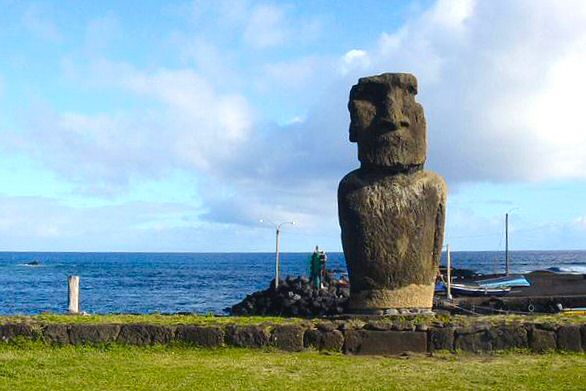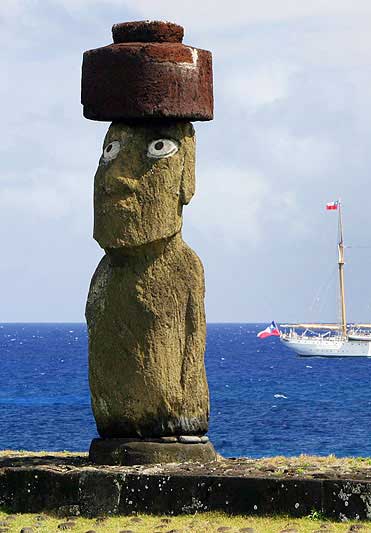 |
usa | world | animals | vocabulary | health | science | math | history |
Easter Island
Easter Island (Polynesian: Rapa Nui ("Great Rapa"), Spanish: Isla de Pascua) is an island in the south Pacific Ocean belonging to Chile. Although located 3,515 km (2,185 miles) west of continental Chile, it is administratively a province (with just one "comuna") of the Chilean Valparaíso Region, together with its closest neighbour, Sala-y-Gomez, 400 km further East. The island is approximately triangular in shape. The latitude is similar to that for the Chilean city of Copiapó, north of Santiago. The nearest inhabited land is Pitcairn Island, located 2,075 km (1,290 miles) to the west. The island has an area of 163.6 km² (63 sq. miles), and a population of 3,791 (2002 census), 3,304 of which live in its capital city Hanga Roa. The island is famous for its numerous moais, 400-year-old stone statues now located along the coastlines.
Easter Island's human history began with the settlement of the island by Polynesians, who are likely to have arrived from the islands of Mangareva or Pitcairn to the west. The history of Easter Island can be related with the aid of a reconstructed king list of Easter Island, complete with events and approximate dates since the 5th century. These Polynesian settlers brought bananas, taro, sweet potato, sugarcane, and paper mulberry, as well as chickens. The island at one time supported a relatively advanced and complex civilization. The European discovery of the island, by the Dutch navigator Jakob Roggeveen, occurred in 1722 on Easter Sunday. Roggeveen found about 2,000-3,000 inhabitants on the island, but it appears that there were as many as 10,000-15,000 of them in the 16th and 17th centuries. The civilization of Easter Island had degenerated drastically during the 100 years before the arrival of the Dutch, owing to the overpopulation, deforestation and exploitation of the extremely isolated island with its limited natural resources. However, by the mid-19th century the population had recovered to about 4,000 inhabitants. Then in a mere 20 years, deportation to Peru and Chile and diseases brought by Westerners almost exterminated the whole population, with only 111 inhabitants left on the island in 1877. The island was annexed by Chile in 1888 (by Policarpo Toro). The native Rapanui have gradually recovered from their low of 111 inhabitants.
Note that the name "Rapa Nui" is not the Rapanui's original name for the island. It was coined by labour immigrants from the original Rapa in the Bass Islands who likened it to their home island. The Rapanui name of Rapa Nui is Te pito o te henua ("Navel of the World") due to its isolation, but this too seems to be derived from another location, possibly a Marquesan landmark.

Recent events have shown a tremendous increase of tourism on the island, coupled with a large inflow of people from mainland Chile, threatening to alter the Polynesian identity of the island. The possession of the land has created political tensions in the past 20 years, with part of the native Rapanui opposed to private property and in favor of the traditional communal property of the land.
Modern Easter Island has virtually no trees. The island once possessed a forest of palms, but it is thought that the native Easter Islanders completely deforested the island in the process of erecting their statues, as well as constructing fishing boats and buildings. There is evidence that the disappearance of the island's trees coincided with the collapse of the Easter Island civilization. Midden contents from that time period show a sudden drop in quantity of fish and bird bones as the islanders lost the means to construct fishing vessels and the birds lost their nesting sites. Chickens and rats became leading items of diet. There is also some evidence of cannibalism, from human remains.
The small surviving population of Easter Island eventually developed new traditions to allot the few remaining resources. In the cult of the birdman (manutara), a competition was established in which every year a representative of each tribe, chosen by the leaders, would dive into the sea and swim across to Motu Nui, a nearby islet, to search for the first egg laid by a Sooty Tern during the season. The first swimmer to return with an egg would secure control of the island's resources for his tribe for the rest of the year. This tradition was still in existence at the time of first contact by Europeans.

The large stone statues, or moai, for which Easter Island is world famous were carved at a later time than was initially thought. Archeologists now estimate that they were carved between 1600 and 1730, the last one being carved around the time when Jakob Roggeveen discovered the island. There are more than 600 large monolithic stone statues, called moai, on the island. Although often identified as "heads", the statues actually have complete torsos; many moai, however, have become buried up to their necks. Most were carved out of the rock at Rano Raraku. The quarry there seems to have been abandoned abruptly, with half-carved statues left in the rock. The most common theory is that the statues were carved by the Polynesian inhabitants (Rapanui) at a time when the island was largely planted with trees and resources were plentiful, supporting a population of 10,000-15,000 native Rapanui. The majority of the statues were still standing when Jakob Roggeveen arrived in 1722. Captain James Cook also saw many standing statues when he landed on the island in 1774. By the 19th century, all the statues had been toppled in internecine wars.

There are tablets found on the island bearing a mysterious script. The script, known as Rongorongo, has never been deciphered despite the work of generations of linguists. A Hungarian scholar, Wilhelm or Guillaume de Hevesy, in 1932 called attention to the apparent similarities between some of the rongorongo characters of Easter Island and those of the prehistoric script of the Indus Valley in India, correlating dozens (at least 40) of the former with corresponding signs on seals from Mohenjo-daro. This correlation has been re-published in later books, for example by Z.A. Simon (1984: 95). The rongorongo may mean peace-peace, and their texts may record peace treaty documents, possibly between the long ears and the conquering short ears. Such explanations have, however, been strongly disputed.
This article is licensed under the GNU Free Documentation License. It uses material from the Wikipedia article "Easter Island".